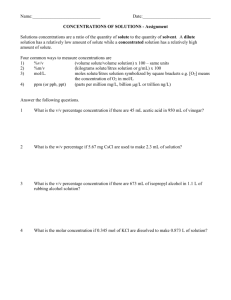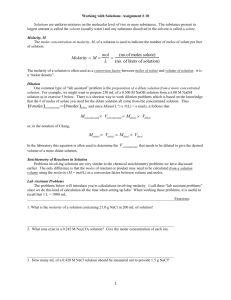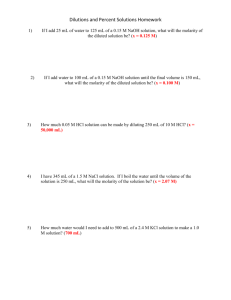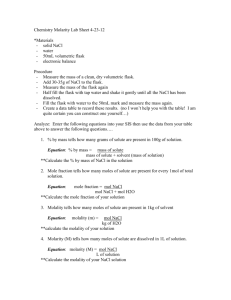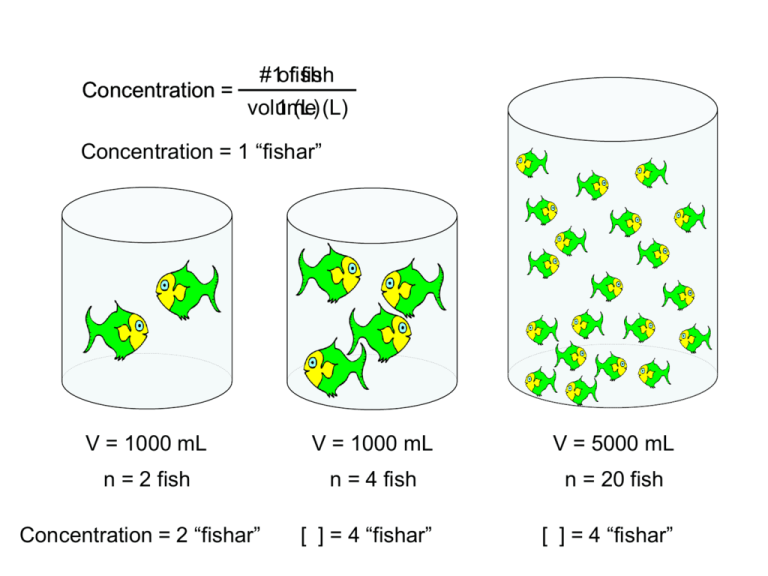
Concentration =
#1offish
fish
volume
1 (L) (L)
Concentration = 1 “fishar”
V = 1000 mL
V = 1000 mL
V = 5000 mL
n = 2 fish
n = 4 fish
n = 20 fish
Concentration = 2 “fishar”
[ ] = 4 “fishar”
[ ] = 4 “fishar”
Concentration =
# of moles
volume (L)
V = 250 mL
n = 8 moles
[ ] = 32 molar
V = 1000 mL
V = 1000 mL
V = 5000 mL
n = 2 moles
n = 4 moles
n = 20 moles
Concentration = 2 molar
[ ] = 4 molar
[ ] = 4 molar
Making
Molar
Solutions
…from liquids
(More accurately, from stock solutions)
Concentration…a measure of solute-to-solvent ratio
concentrated
“lots of solute”
vs.
dilute
“not much solute”
“watery”
Add water to dilute a solution; boil water off to concentrate it.
remove
sample
moles of
solute
initial solution
Making a
Dilute
Solution
mix
same number of
moles of solute
in a larger volume
diluted solution
Timberlake, Chemistry 7th Edition, page 344
Concentration
“The amount of solute in a solution”
A. mass % = mass of solute
mass of sol’n
% by mass – medicated creams
% by volume – rubbing alcohol
B. parts per million (ppm) also, ppb and ppt
– commonly used for minerals or
contaminants in water supplies
C. molarity (M) = moles of solute
L of sol’n
mol
– used most often in this class
M =
D.
mol
L
molality (m) = moles of solute
kg of solvent
M
L
ppm 1 inch in 16 miles
ppb 1 inch in 16,000 miles
ppt 1 sec = 32,000 years
Glassware
Glassware – Precision and Cost
beaker
vs.
volumetric flask
When filled to 1000 mL line, how much liquid is present?
beaker
5% of 1000 mL = 50 mL
volumetric flask
1000 mL + 0.30 mL
Range: 950 mL – 1050 mL
Range: 999.70 mL– 1000.30 mL
imprecise; cheap
precise; expensive
Markings on Glassware
Beaker
500 mL + 5%
Range = 500 mL + 25 mL
475 – 525 mL
Graduated Cylinder 1000 mL + 5 mL
Range = 1000 mL + 5 mL
475 – 525 mL
Volumetric Flask 500 mL + 0.2 mL
Range = 499.8 – 500.2 mL
TC 20oC “to contain at a temperature of 20 oC”
TD “to deliver”
22
s
T
“time in seconds”
water in
grad. cyl.
mercury in
grad. cyl.
~
~
~
~
~
~
~
~
Measure to part of meniscus w/zero slope.
Copyright © 2007 Pearson Benjamin Cummings. All rights reserved.
How to mix solid chemicals
Lets mix chemicals for the upcoming soap lab.
We will need 1000 mL of 3 M NaOH per class.
How much sodium hydroxide will I need, for five classes, for this lab?
mol
M =
L
? mol
3M =
1L
How much will this weigh?
? = 3 mol NaOH/class
x 5 classes
15 mol NaOH
1 Na @ 23g/mol + 1O @ 16g/mol + 1 H @ 1 g/mol
MMNaOH = 40g/mol
X g NaOH = 15.0 mol NaOH
40.0 g NaOH
= 600 g NaOH
1 mol NaOH
FOR EACH CLASS:
To mix this, add 120 g NaOH into 1L volumetric flask with
~750 mL cold H2O.
Mix, allow to return to room temperature – bring volume to 1 L.
How to mix a Standard Solution
Wash bottle
Volume marker
(calibration mark)
Weighed
amount
of solute
Zumdahl, Zumdahl, DeCoste, World of Chemistry 2002, page 480
How to mix a Standard Solution
http://www.chem.ucla.edu/~gchemlab/soln_conc_web.htm
Process of Making a Standard
Solution from Liquids
Zumdahl, Zumdahl, DeCoste, World of Chemistry 2002, page 483
How to mix a dilute solution from a
concentrated stock solution
Copyright © 2007 Pearson Benjamin Cummings. All rights reserved.
Reading a pipette
Identify each volume to two decimal places
(values tell you how much you have expelled)
4.48 - 4.50 mL
4.86 - 4.87 mL
5.00 mL
www.chalkbored.com
Dilution of Solutions
Molarity
Reagent
Percent
To Prepare 1
Liter of one molar
Solution
1.05
17.45
99.8%
57.3 mL
35.05
0.90
14.53
56.6%
69.0 mL
Formic Acid (HCOOH)
46.03
1.20
23.6
90.5%
42.5 mL
Hydrochloric Acid (HCl)
36.46
1.19
12.1
37.2%
82.5 mL
Hydrofluoric Acid (HF)
20.0
1.18
28.9
49.0%
34.5 mL
Nitric Acid (HNO3)
63.01
1.42
15.9
70.0%
63.0 mL
Perchloric Acid 60% (HClO4)
100.47
1.54
9.1
60.0%
110 mL
Perchloric Acid 70% (HClO4)
100.47
1.67
11.7
70.5%
85.5 mL
Phosphoric Acid (H3PO4)
97.1
1.70
14.8
85.5%
67.5 mL
Potassium Hydroxide (KOH)
60.05
1.05
17.45
99.8%
57.3 mL
Sodium Hydroxide (NaOH)
40.0
1.54
19.4
45.0%
85.5 mL
Sulfuric Acid (H2SO4)
98.08
1.84
18.0
50.5%
51.5 mL
Solution Guide
Formula
Weight
Specific
Gravity
Acetic Acid Glacial (CH3COOH)
60.05
Ammonium Hydroxide (NH4OH)
MConc.VConc. = MDiluteVDilute
Dilutions of Solutions Acids (and sometimes bases) are
purchased in concentrated form (“concentrate”) and are easily
diluted to any desired concentration.
**Safety Tip: When diluting, add acid or base to water.**
Dilution Equation:
MC VC MD VD
C = concentrate
D = dilute
Concentrated H3PO4 is 14.8 M. What volume of concentrate
is required to make 25.00 L of 0.500 M H3PO4?
MC VC MD VD 14.8 M (VC ) 0.500 M (25.00 L)
VC = 0.845 L = 845 mL
How would you mix the above solution?
1. Measure out 0.845 L of concentrated H3PO4 .
2. In separate container, obtain ~20 L of cold H2O.
3. In fume hood, slowly pour [H3PO4] into cold H2O.
4. Add enough H2O until 25.00 L of solution is obtained.
Be sure to wear your safety glasses!
You have 75 mL of conc. HF (28.9 M); you need 15.0 L of
0.100 M HF. Do you have enough to do the experiment?
MCVC = MDVD
28.9 M (0.075 L) = 0.100 M (15.0 L)
Yes;
we’re OK.
2.1675 mol HAVE > 1.50 mol NEED
Dilution
• Preparation of a desired solution by
adding water to a concentrate.
• Moles of solute remain the same.
M1V1 M 2V2
Dilution
• What volume of 15.8M HNO3 is required to
make 250 mL of a 6.0M solution?
GIVEN:
M1 = 15.8M
V1 = ?
M2 = 6.0M
V2 = 250 mL
WORK:
M1 V1 = M2 V2
(15.8M) V1 = (6.0M)(250mL)
V1 = 95 mL of 15.8M HNO3
Preparing Solutions
How to prepare 500 mL
of 1.54 M NaCl solution
– mass 45.0 g of NaCl
– add water until total volume is
500 mL
500 mL
mark
45.0 g NaCl
solute
500 mL
volumetric
flask
Preparing Solutions
molality
molarity
1.54m NaCl in
0.500 kg of water
500 mL of 1.54M NaCl
– mass 45.0 g of NaCl
– add 0.500 kg of water
– mass 45.0 g of NaCl
– add water until total volume is
500 mL
500 mL
water
45.0 g
NaCl
500 mL
mark
500 mL
volumetric
flask

